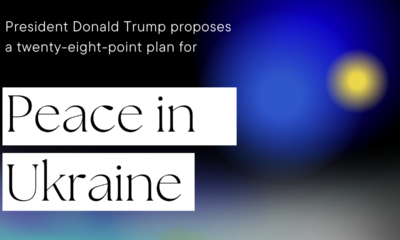Civilization
Tut’s Treasures Up Close

Residents and visitors to the nation’s capital can find a perfect escape from the summer heat—and hotter politics—by traveling back in time 33 centuries to re-live one of the most spectacular archeological finds in history.
The latest Tut exhibit
“Tutankhamun: His Tomb and His Treasures” has opened in an exhibition space in a hip new part of DC with room to display the more than 1,000 full-scale recreations of the burial artifacts discovered in 1922 when the young king’s burial tomb was unsealed in the Egyptian desert.
Experts attest that the museum-quality recreations are exact replicas of the originals—thrones, chariots, statutes, and even room-sized burial chambers in glittering gold. The sheer extravagance is astonishing.
I spoke with Egyptologist and Professor Melinda Hartwig who said this is the most historically accurate traveling Egyptian exhibition on King Tut ever mounted. She said she has seen and studied the original pieces in Cairo and is awed at the accuracy of these recreations.
This exhibit is more experiential and far more spectacular than the original Tut exhibit that captivated the nation when it opened at the National Gallery of Art in 1976.
The original King Tut exhibit displayed 55 artifacts so valuable they had to be transported on U.S. Navy ships from Cairo to D.C. This exhibit has more than 1,000 artifacts, most of which you can reach out and touch—a treasure trove of breathtaking artistry.
Tut’s tomb contained by far the most complete example of a royal set of burial goods in Egypt’s Valley of the Kings, with 5,398 objects. Most of the authentic items are in storage in Egypt and not open for public view at present.
How they found Tut’s tomb
Egyptologist Howard Carter had been digging for years in the Valley of the Kings—the ancient burial site of Egypt’s pharaohs—but was running out of time and money from his sponsor. He was obsessed with finding the tomb that he knew had to be somewhere in that vast desert.
The exhibit recreates Carter’s experience of finally finding a hidden staircase leading to a sealed door. He drilled a hole in the door and peeked inside.
“At first, I could see nothing, the hot air escaping the chamber causing the candle flame to flicker, but presently, as my eyes grew accustomed to the light, details of the room within emerged slowly from the mist, strange animals, statues, and gold,” he wrote about the discovery.
You see what he saw: Priceless artifacts lay jumbled all around: thrones, boxes, vases, chariots, statues, weapons, and more. Ancient grave robbers most likely created the disorder. We never will know what they carried away, but the treasures that were left were almost beyond comprehension.
For this new exhibit, skilled contemporary Egyptian craftsmen have constructed replicas of everything from the famous burial mask to the young king’s thrones to the golden sarcophagus housing the mummy.
Life of King Tutankhamen
King Tut ascended the throne in 1332 B.C. when he was only nine years old and reigned fewer than ten years before his death—most likely from complications of a broken leg—most likely from a chariot accident.
Visitors can view the recreations—from the three enormous nesting burial chambers to the beautiful frescoes on the walls that tell the king’s short life story to the most precisely crafted statues. The exhibit is housed not in a Smithsonian museum on the Washington Mall but in a private exhibit space with space to display so many treasures.
“In perhaps the greatest departure from the standard museum experience, you can even reach out and touch the replicas, tracing the hieroglyphs that spell out Tutankhamun’s name on the back of his throne or running your hands across the smooth surface of his death mask,” the Smithsonian Magazine writes in a glowing review. Children love it.
I can’t do it justice here, but I was awed by every piece, down to the fine jewelry and even the cosmetics. Beauty was everything to the Egyptians.
Reception
“Tutankhamun: His Tomb and His Treasures” is privately funded, produced in collaboration of Exhibition Hub, Semmel Exhibitions, and Fever. “Contemporary Egyptian craftsmen, under the guidance of world-renowned Egyptologists, meticulously reproduced every detail to create the most comprehensive collection in the world. This exhibition offers the closest experience to visiting King Tut’s tomb and treasures without traveling to Egypt,” the website says.
Millions of people lined up for hours to see the original Smithsonian exhibit. This one has been traveling the globe for more than 15 years, visited by more than 7 million people, and is much more accessible and has a big parking lot out front. The audio tour is worth the extra fee to learn the rich details of King Tut’s story as you view the treasures.
Tickets here. DC website. Location: The Rhode Island Center, 524 Rhode Island Ave NE, Washington, DC, through September 22.
This article was originally published by RealClearBooks and made available via RealClearWire.
Grace-Marie Turner is a former journalist and award-winning feature writer who currently runs a non-profit research institute focusing on free-market health reform.
-

 Civilization4 days ago
Civilization4 days agoTrump’s Venezuela Gamble and America’s Shifting National Security Strategy
-

 Civilization4 days ago
Civilization4 days agoOperation Absolute Resolve: Anatomy of a Modern Decapitation Strike
-

 Civilization4 days ago
Civilization4 days agoTen Reasons To Cheer the Arrest of Maduro
-

 Civilization2 days ago
Civilization2 days agoOne Fell Swoop: Lawsuit Eyes Death Blow to Racial Preferences
-

 Civilization22 hours ago
Civilization22 hours agoTrump’s New Doctrine of Precision Deterrence
-

 Executive2 days ago
Executive2 days agoWaste of the Day: $1.6T in Wasteful Spending in Rand Paul’s “Festivus” Report
-

 Guest Columns3 days ago
Guest Columns3 days agoAdvice to Democrats Regarding Maduro Arrest: Resist Reflexive Opposition
-

 Civilization4 days ago
Civilization4 days agoTrump’s New Executive Order on Space Has the Right Stuff














